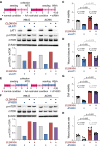Extrajunctional CLDN10 cooperates with LAT1 and accelerates clear cell renal cell carcinoma progression
- PMID: 39639312
- PMCID: PMC11619122
- DOI: 10.1186/s12964-024-01964-5
Extrajunctional CLDN10 cooperates with LAT1 and accelerates clear cell renal cell carcinoma progression
Abstract
Background & aims: In addition to their adhesive properties, cell adhesion molecules such as claudins (CLDNs) exhibit signaling ability to organize diverse cellular events. Although the CLDN-adhesion signaling stimulates or inhibits cancer progression, the underlying mechanism remains poorly established. Here, we verified whether and how CLDN10 promotes intracellular signals and malignant phenotypes in clear cell renal cell carcinoma (ccRCC).
Methods: We developed a novel monoclonal antibody that specifically recognizes CLDN10. By immunohistochemistry using this antibody, the clinicopathological significance of aberrant CLDN10 expression in 165 ccRCC patients was determined. We next generated the ccRCC cells (786-O, ACHN, and OS-RC-2) expressing CLDN10, and compared their phenotypes with those of control cells. Immunoprecipitation-mass spectrometry was used to identify a CLDN10-interacting protein, followed by evaluation of its association with CLDN10 and loss-of-functions in ccRCC cells.
Results: High CLDN10 expression predicted poor outcome in ccRCC patients and represented an independent prognostic marker for cancer-specific survival. Cell surface CLDN10 promoted cell viability, proliferation, and migration of ccRCC cells, as well as their tumor growth. CLDN10 also activated mTOR signaling and expression of downstream targets, including MYC target genes. Notably, we found that CLDN10 forms a complex with an amino acid transporter, LAT1, and that CLDN10-LAT1 signaling facilitates malignant phenotypes in ccRCC cells. Structural prediction and immunoprecipitation analysis results strongly suggest an interaction between CLDN10-TM1 (transmembrane domain 1) and LAT1-TM4.
Conclusions: We conclude that CLDN10-LAT1 signaling drives ccRCC progression. Taken together with our previous findings on CLDN-Src-family kinases signaling, CLDNs propagate distinct intracellular signals depending on their association with different binding partners.
Keywords: CD98; Cell adhesion signal; Claudin; JPH203; Renal cancer; Tight junction; mTOR.
© 2024. The Author(s).
Conflict of interest statement
Declarations. Ethics approval and consent to participate: All animal experiments conformed to the National Health Guide for the Care and Use of Laboratory Animals and were approved by the Animal Experiments Committee of Fukushima Medical University (approval code, 067 and 2022097; approval date, Jul 1, 2017 and Oct 27, 2022). The human studies were approved by the Research Ethics Committee of Fukushima Medical University (approval code, 2021-098; approval date, 29 June 2021) and were conducted in accordance with the 1964 Helsinki Declaration or comparable standards. Consent for publication: Not applicable. Competing interests: The authors declare no competing interests.
Figures






References
-
- Bray F, Laversanne M, Sung H, Ferlay J, Siegel RL, Soerjomataram I, et al. Global cancer statistics 2022: GLOBOCAN estimates of incidence and mortality worldwide for 36 cancers in 185 countries. CA Cancer J Clin. 2024;74:229–63. - PubMed
-
- Woods P. Kidney cancer statistics [Internet]. WCRF International. 2022 [cited 2024 Apr 10]. http://www.wcrf.org/cancer-trends/kidney-cancer-statistics/
-
- Capitanio U, Montorsi F. Renal cancer. Lancet. 2016;387:894–906. - PubMed
-
- Stewart GD, Klatte T, Cosmai L, Bex A, Lamb BW, Moch H, et al. The multispeciality approach to the management of localised kidney cancer. Lancet. 2022;400:523–34. - PubMed
MeSH terms
Substances
Grants and funding
LinkOut - more resources
Full Text Sources
Medical
Research Materials
Miscellaneous

